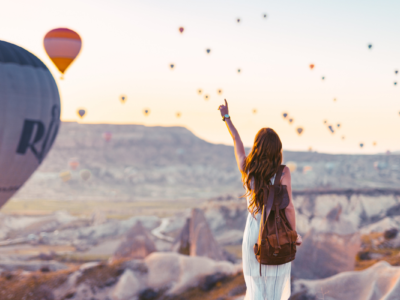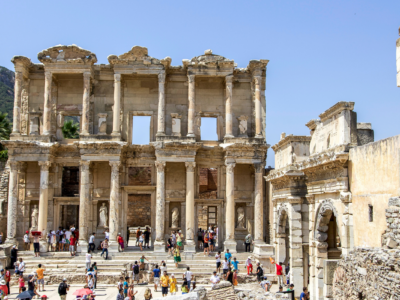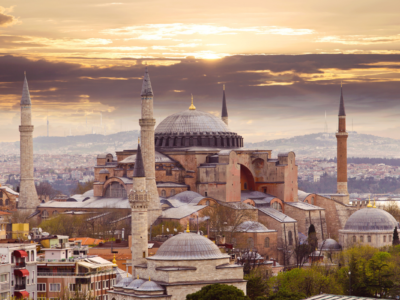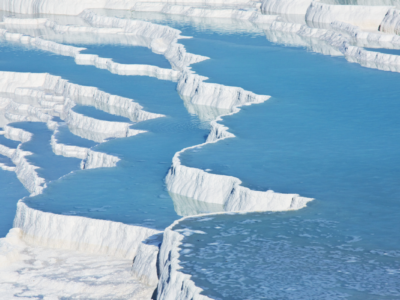7 Days İstanbul – Cappadocia – Ephesus – Pamukkale Tour
TOUR INFO AND ITINARY
DAY 1
ARRIVAL TO ISTANBUL
Upon your arrival to İstanbul, we will fetch you from the airport and transfer you to your hotel. Overnight in the hotel.
DAY 2
SULTANAHMET OLD CITY TOUR
This is a full day walking city tour starting from your hotel. Your tour guide will pick you from your hotel any time you want and s/he will be at your service and guide you during the day for about 8 hours. At the start, your private licenced tour guide (in your mother tongue) will come and collect you from your hotel, preferably at morning time, and drive/walk you to downtown Sultanahmet. The guide will tell you all the history and importance of the monuments in detail. Having a private tour guide comes in handy. For example, you will realize in situ that in front of every major museum, there are long queues. But, there is no need to panic; when you are under the umbrella of your private tour guide, you do not have to wait for long queues. You will forge ahead hassle-free and the guide will get you in rapidly. That will save you a lot of time. Licenced guides and his/her people in company are allowed to get in museums without waiting for long queues. Additionally, when you have your private guide, you do not have to wait for other people in the group as in regular tours that is oftentimes burdensome. During the tour, it is suggested that you shall visit Hagia Sophia, Blue Mosque, Hippodrome and Obelisks, Cistern Basilica, Süleymaniye Mosque, Topkapı Palace, Grand Bazaar, Spice Bazaar and Dolmabahçe Palace. There will be a lunch break any time you want. You will also be given free time at Grand Bazaar for shopping. Your guide will help you for some bargaining games which is part of the shopping in Turkey. At the end of the tour, you will be transferred to your hotel.
Altogether, this will be a cultural tour of "Sultanahmet Old City" from where the Byzantine and Ottoman Empires were ruled. You will be mesmerized by the grandeur of those empires that left their traces in İstanbul. At the end of the tour, you will have a great collection of pictures and videos. Having your own private tour guide in your own language will make all the difference. Since it is a private tour, you set your own agenda, you can start from whichever monument you want! Below, you can find a short summary of the places you shall be visiting during the tour.
Hagia Sophia, once described as the greatest church in Christendom, is certainly a masterpiece with a synthesis of the Occident and the Orient. Built by Constantine the Great in 325 on the remains of a pagan temple. Rebuilt by Justinian and Theodora. In 1453, Mehmet the Conqueror added minarets to the huge, soaring dome and turned the former church into a mosque. The building controversially became a museum in 1935, but the interior retains its religious ramifications with the Christian mosaics and Muslim calligraphic disks adorning its walls and piers. For the time being, it serves as a mosque again.
Blue Mosque, also known as Sultan Ahmed Mosque, this breathtaking building is one of the most majestic Ottoman mosques in all of Turkey. The Blue Mosque was built between 1609 and 1616, by the architect Mehmet Ağa, instructed by Sultan Ahmed I. It was designed as an imperial show of strength to complement the imposing Hagia Sophia, which faces it across Sultanahmet Square. Unlike the Hagia Sophia, it is supported by four 'elephant foot' pillars, and the central dome is flanked by four semi-domes, making it nearly a square in shape. It is dubbed the Blue Mosque because of over 20,000 handmade ceramic Iznik tiles that decorate the interior, featuring many different tulip, rose, carnation, and lily designs, well lit by 260 windows. Aside from its staggering size and exquisite beauty, one of the most distinctive elements of this Istanbul mosque is that it has six minarets, as opposed to the usual two or four of most of the city’s mosques.
Hippodrome, a public park used in the days of the Byzantine Empire for ceremonies and sporting events (chariot races, athletics). Theodosius Obelisk, Serpentine Column, Column of Constantine and German Fountain of Wilhelm II are the monuments decorating Hippodrome.
Cistern Basilica, known locally as Yerebatan Sarayı (Sunken Palace) or Yerebatan Sarnıcı (Sunken Cistern) this underground water cistern was the major water reservoir of Constantinople. The water was transported from the Belgrade Forest by the immense Byzantine aqueducts (Valens Aqueducts). It was built during the reign of Emperor Constantine in the 4th Century but greatly enlarged by Justinian in 537 AD, and used as water storage for the Great Palace during Byzantine times and for the Topkapi Palace under the Ottomans.
Süleymaniye Mosque, the truly staggering size of the Süleymaniye Camii (Suleymaniye Mosque) is one of its most distinctive features – built by the legendary architect, Mimar Sinan, it is known as one of his masterpieces, and his largest design. It is not just the awe-inspiring size that is impressive (the central dome stands 47m high), but also the elegantly decorated interior. The sense of space and light is emphasized the supporting semi-domes to the northwest and southeast and the monumental arched spaces to the southwest and northeast.
Grand Bazaar, is the oldest and biggest closed bazaar of the world. It was founded in 1461. Like an enormous labyrinth, it is a spectacular and unique part of Istanbul with 17 doors, 60 streets and over 3000 stores. The Grand Bazaar offers a wide range of products from copper to glazed tiles, from marriage articles to ready wear, and from various handicrafts to all types of spice. Western writers often mention the Grand Bazaar in their memories and travel journals and it is seen in some movies like James Bond.
Topkapı Palace, which had been the seat of government for the Ottoman Empire that ruled three continents for centuries, was constructed between the years of 1460 and 1478 during the reign of Sultan Mehmed II (The Conqueror). It was home to the sultans and their families until the reign of Sultan Abdülmecit. Therefore, it has a very rich collection of porcelains, robes, weapons, shields, armors, miniatures, Islamic calligraphic manuscripts as well as Ottoman treasures and jewellery.
Spice Bazaar, No visit to Istanbul is complete without stopping by the atmospheric Spice Bazaar. While the Grand Bazaar may be the largest and most famous of Istanbul's covered bazaars, this spice market wins the prize for being the most colorful, fragrant, and often the most fun as visitors can taste the goods on offer. It must definitely be on your shopping places list.
Dolmabahçe Palace, if you take a Bosphorus tour, you will pass many lavish and intriguing buildings, but the most opulent of them all, surely has to be the 600m long Dolmabahçe Sarayı (Dolmabahce Palace). It took 13 years to build and was completed in 1856, and served as the administrative center of the Ottoman Empire until 1922.
The palace was commissioned by Sultan Abdülmecid who decided that there should be a more European palace than Topkapı Palace and designed by Armenian architect Karabet Balian and his son. It is an ostentatious blend architectural styles including Baroque, Rococo, Neoclassical and modern Ottoman, dripping in luxury. It must be added that the father of modern Turkey, Mustafa Kemal Atatürk has lived and passed away in this palace.
DAY 3
DISCOVERY OF TWO CONTINENTS AND BOSPHORUS CRUISE
This is a full day city tour with bus and boat. The tour starts by picking you up from your hotel at about 08.30am and ends up by dropping you off back to your hotel at about 17.30pm. During the tour, you will be visiting some of the most remarkable highlights of İstanbul. First, you will be driven to Dolmabahçe Palace to visit the interior parts. After that, you will be taken to Asian Side to visit the highest point of İstanbul, Çamlıca Hill by passing across Bosphorus Bridge. You will get the sense of passing from one continent to another. Then you will be taken back again to European Side to visit Pierre Lotti Hill and have a cable car tour. The bus tour will end up by passing the Ancient City Walls and you will be transferred to your boat to do the Bosphorus Cruise. You will be given open buffet free lunch with 30 different dishes. On the way, you will sail along the Eurpean Side up until the third bridge and on the way back, you return from the Asian Side so that at the end of the tour you will have great collection of pictures and videos. All along, there will be a private licenced tour guide who will explain you the history and importance of the monuments. It will be an unforgettable day trip. At the end of the tour, you will be transferred back to your hotel. Below, you can find the summary of the places you will be visiting during the tour.
Dolmabahçe Palace, if you take a Bosphorus tour, you’ll pass many lavish and intriguing buildings, but the most opulent of them all, surely has to be the 600 m long Dolmabahçe Sarayı (Dolmabahce Palace). It took 13 years to build and was completed in 1856, and served as the administrative center of the Ottoman Empire until 1922.
The palace was commissioned by Sultan Abdülmecid who decided that there should be a more European palace than Topkapı Palace and designed by Armenian architect Karabet Balian and his son. It is an ostentatious blend architectural styles including Baroque, Rococo, Neoclassical and modern Ottoman, dripping in luxury. It must be added that the father of modern Turkey, Mustafa Kemal Atatürk has lived and passed away in this palace.
Çamlıca Hill, a trip to İstanbul would not be complete without a visit to Çamlıca Hill, the highest point of İstanbul. At this height, the mighty İstanbul looks like a gigantic carpet of sea and forest where the houses snaking through it. With Çamlıca Mosque located on the cliff, it is a wonder of man-made architecture that paves the way for awe-inspiring views.
Pierre Loti Hill, this wonderful viewpoint has a commanding view over İstanbul. Facing towards the Golden Horn of the Bosphorus waterway, many choose to spend time drinking a traditional tea or coffee at the cafe on the hill to take the view. The hill was named after a French writer who specialised in impressionistic style writing. After visiting İstanbul for the first time in 1876 as an officer on a French ship, he felt impressed by the Ottoman way of life. During his time in Istanbul, he lived in the Eyup area, which includes the hill.
Bosphorus Cruise, Bosphorus Strait is the natural symbol and icon of İstanbul. For the locals of İstanbul, the Bosphorus Strait is simply the most beautiful place in the world, and there’s no better way to see it than from the water. This important waterway is such a defining feature of İstanbul and the Bosphorus cruise along it gives visitors a chance to delve into the city’s past and today. Lined with extravagant palaces, crumbling wooden mansions, lush gardens, tiny fishing villages and an unparalleled array of spots to watch as the boat goes by, the Bosphorus offers something for everyone.
DAY 4
İSTANBUL TO CAPPADOCIA – RED TOUR
We will pick you up from your hotel early in the morning and transfer you to the airport. You will take a short flight to Kayseri/ Nevşehir. Upon your arrival, we will meet you with your names at the airport and drive you to our branch office in Cappadocia. You will meet with the local licenced tour guide and off you go to visit the top highlights in the North Cappadocia which is also known as Red Tour. Having done the Red Tour, you will be transferred to your cave hotel which will give you a unique experience with its fairy-tale ambiance. Below, you can find a short summary of the places you will be visiting during the Red Tour:
The Göreme Open Air Museum, is one of Turkey's Unesco World Heritage sites. It was an important Byzantine monastic settlement that housed some 20 monks, then a pilgrimage site from the 17th century, this splendid cluster of monastic Byzantine artistry with its rock-cut churches, chapels and monasteries is 1km uphill from Göreme's centre.
The Uçhisar Castle, this tall volcanic-rock outcrop is one of Cappadocia's most prominent landmarks and visible for miles around. Riddled with tunnels, it was used for centuries by villagers as a place of refuge when enemy armies overtook the surrounding plains.
Paşabağ Three-headed Fairy Chimneys, Paşabağ contains some of the most striking fairy chimneys in Cappadocia with twin and even triple rock caps - formations that are unique even for Cappadocia! Locals refer to them as the mushroom-shaped fairy chimneys.
Avanos Pottery Town, it is well known throughout the country and abroad for the red clay products made by locals. Hundreds of the village men are skilled in making pots, plates, wine holders, and even ashtrays and chess sets. They are pottery masters and their skills have mostly been handed down from generation to generation.
Ürgüp town, with conical shaped body and a boulder on top of it. Three Graces (Üç Güzeller) are the brilliant three fairy chimneys.
Devrent Imagination Valley, the small fairy chimneys in the valley form a lunar landscape, or moonscape, by their strange look. The valley has many animal shaped rocks. It looks like a sculpture zoo made by nature.
DAY 5
BALLOON FLIGHT – GREEN TOUR – OFF TO EPHESUS
We will pick you up from your hotel quite early in the morning to do one hour hot air balloon flight over Cappadocia. This once in a lifetime experience will be an unforgettable memory. End of the flight, there will be a small celebration and then we will drive you back to the hotel. Breakfast will be served at the hotel. Again, we will pick you up from the hotel at about 10.00am to visit South Cappadocia which is also known as Green Tour. At the end of the tour, you will be transferred to the Kayseri/Nevşehir Airport and take a flight back to Ephesus. Upon your arrival, we will welcome you at the airport and transfer you to your hotel in Kuşadası. Below, you can find a short summary of the places you will be visiting during the Green Tour:
Kızılçukur, it is a must visit in Cappadocia as the orchards, vineyards, rock churches and fairy chimneys all blend together to create an unforgettable landscape.
Kaymaklı Underground City, the widest, enchanting, one of the most famous and wonderful underground city in Cappadocia. You will see ventilation shafts and a winery, the massive stone doors, a food storage room, and various other large rooms and small tunnels.
Çavuşin, the old village, which was abandoned several decades ago due to rock falls, was all carved into the hillside. The inhabitants of Çavuşin lived in houses which were cut into a massive rock wall.
Pigeon Valley, the name comes from the thousands of pigeon houses that have been carved into the soft tuff since ancient times. Although they can be found throughout Cappadocia, they are especially numerous in this valley. They were carved wherever space allowed, including abandoned cave houses and churches.
Esentepe Viewpoint, overlooking the small, quaint town of Göreme and Pigeon Valley, Esentepe Viewpoint is one of the favorite places in Cappadocia.
Çatalkaya, explore the rock formations in Çatalkaya.
DAY 6
EPHESUS TOUR
After the breakfast, we will take you to the sightseeing point and the fully guided Ephesus Tour will start. The guide will tell you all the history and importance of the monements. Some of the most important highlights will be visited. At the end of the tour, you will be transferred to your hotel. Below, you can find a short summary of the places you will be visiting during the Ephesus Tour:
Ephesus Ancient City, an outstanding example of a Roman port city, with sea channel and harbour basin. It was Hellenic Greece capital city and was the capital of the Roman Empire’s province of Asia. Ephesus was economically, geographically, politically and culturally significant. Many famous classical philosophers who are still admired today such as Heraclitus, lived in the scientific, cultural and artistic city of Ephesus.
En route, you will see some of the finest monuments such as: Magnesia Gate, Odeon (Concert Hall), The Baths of Varius (used as a Gymnasium), Prytaneion (administrative offices also where religious ceremonies, official receptions and banquets were held). Plus, Agora (commercial market of Ephesus), The Temple of Hadrian (dedicated to Emperor Hadrian, Artemis and the people of Ephesus), The Fountain of Trajan (constructed for the honor of Emperor Trajan) and the Great Theatre will also be visited. The theatre had seating for 24.000 people which was the site where it is believed St. Paul preached to the Ephesians and is used today for a local spring festival.
Celsus Library, the most distinctive building and one of the most photographed structure that is commonly associated with Ephesus. It was erected by Gaius Julius Aquila (son of Tiberius Julius Celsus Polemaeanus). Assumed that the construction was completed in 117 A.D. It is made of very good marble and decorated with figures of Eros, Nike, rosettes and garlands in relief.
House of Virgin Mary, is close to the peak of Bülbül Mountain, one of the hills overlooking Selçuk. After the death of Jesus Christ, Virgin Mary had gone to Ephesus with Saint John and lived here until her death at the age of 101. Thus, this church is an important pilgrimage center for Christians. There is also a spring believed to be curative. The Popes Paul VI and Jean Paul II visited this house. The House of Virgin Mary is declared to be sacred and an important pilgrimage spot visited by Christians from all over the world.
The Temple of Artemis, was in its day the largest in the world, eclipsing even the Parthenon at Athens, and thus earning a spot on the list of the Seven Wonders of the Ancient World. Only one of its original 127 columns remains, often as not topped by a stork’s nest; a poignant testament to the transitory nature of human achievement. Still it is a lovely tranquil place, the enormous pillar giving you some indication of the vast size of the temple.
İsa Bey Mosque, with the order of Aydinoğullari Emirate İsa Bey, was built in 1375. It is a nice sample of Seljuk Turkish architecture. It is on the western side of Ayasuluk Hill on which stand the fortress and the church of Saint John.
DAY 7
PAMUKKALE TOUR – BACK TO iSTANBUL
We will pick you up early in the morning from your hotel and transfer you to the sightseeing area and the fully guided Pamukkale Tour will start. The guide will tell you all the history and importance of the monements. Some of the most important highlights will be visited. At the end of the tour, you will be transferred to airport and return back to İstanbul. On the way back, you will have great collection of pictures and videos. Below, you can find a short summary of the places you will be visiting during the Pamukkale Tour:
Pamukkale, is a unique, magical wonder of the nature with its dazzling white and stoned castles. The thermal waters with limestone and salt, pouring by the bank of the plateau form up these marvelous stalacites, waterfalls and pools. These healing warm waters have been used for therapy since the Roman time. Visitors are allowed to walk in the cascading pools, that leads to squashing and dispersing the soft jelly of calcium carbonate.
Hierapolis, is on the same plateau with the thermal pools providing visitors with a glimpse of the natural gifts of the region and cultural riches that man added to nature. The ancient city, situated 20 kilometres north of Denizli, is justly famous for the buildings and artefacts unearthed during extensive excavations. Hierapolis is known as the ‘Sacred City’ on account of its many temples and religious buildings. The geographers of antiquity, Strabo and Ptolemy, claimed that Hierapolis was a Phrygian city, because of its proximity to Laodicea on the Lycus and Tripolis, cities situated on the border with the Caria region.
Red Water Springs, at the north of Pamukkale in Karahayit Village. Due to having much higher content, the water appear red. The water also much hotter than Pamukkale water. You can enjoy seeing the water comes from the travertines in red color. You will be astounded by the magic of nature.
What is Included: All transfers, round trip flight tickets, hotel accomodations, tour lunches, all entrance fees, professional licenced tour guide in English.
Tips for Package Tours: Take some heavy jacket to protect yourself from cold. Bring camera to shoot some awesome photos and videos.
Cost: The price is changeable based on season, flight tickets, demands and requests, and number of people. Please contact us for the best available prices.





